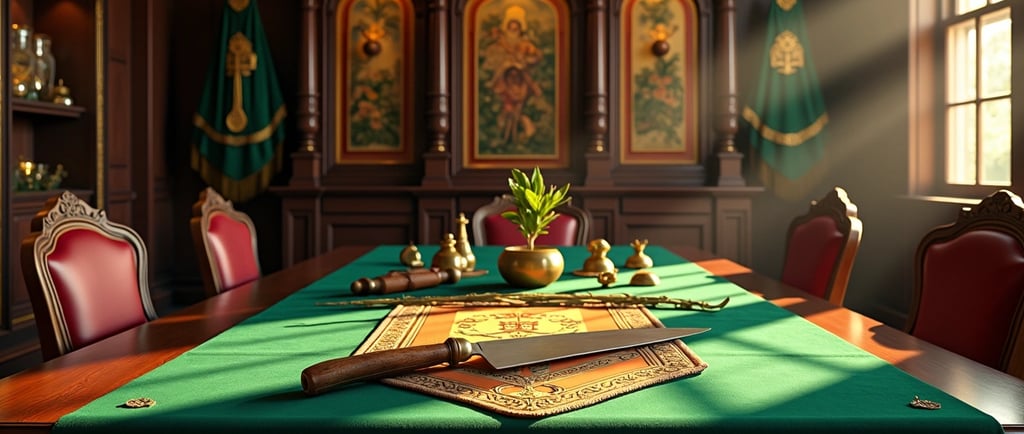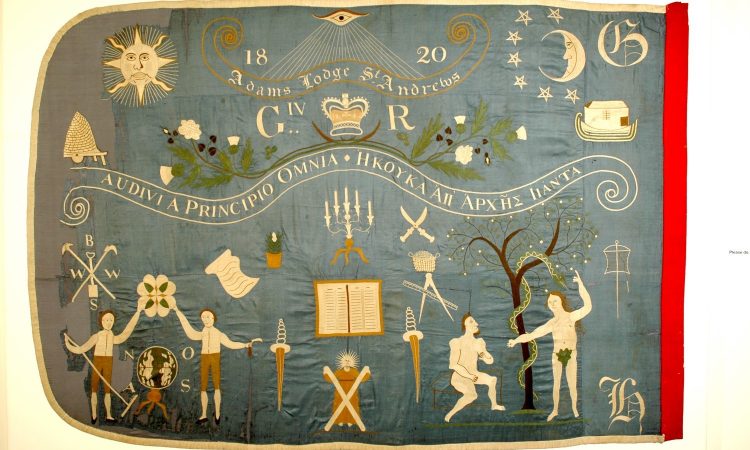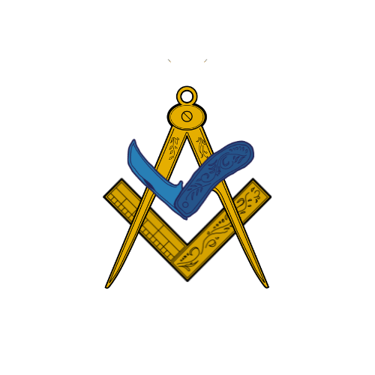The Secret History of the Ancient Order of Free Gardeners: A Lost Brotherhood Revealed
Did you know that by 1849, approximately 60% of adult males in Britain—around four million workers—belonged to some sort of friendly society? Among these organizations, the ancient order of free gardeners stands out as a fascinating brotherhood with roots stretching back centuries.
HISTORY OF THE ANCIENT ORDER OF FREE GARDENERS
WB James Paredes
9/1/202511 min read


Founded in Haddington, Scotland in 1676, the ancient order of free gardeners Scotland began as a modest group but quickly flourished throughout the British Isles. In fact, at the peak of their influence, more than 10,000 Free Gardeners existed in the Lothians alone, spread across over 50 lodges. The first Dunfermline lodge, established in 1716, initially gathered 214 members and subsequently grew as its social standing increased. What's particularly remarkable is that by the 1870s, the British order of ancient free gardeners had expanded to include four times more members than Trade Unions.
In this article, we'll explore the rich history of this once-powerful brotherhood, examining their symbols, rituals, and social impact. We'll also investigate how this independent ancient order of free gardeners transformed from a simple gardeners' guild into a significant social institution before gradually fading into obscurity. Though largely forgotten today, the ancient order of free gardeners symbols and practices reveal a fascinating chapter in the history of fraternal organizations and working-class mutual aid societies.
The Parade That Captured a Town: A Glimpse into 1844
July 1844 marked a spectacular moment in the history of the ancient order of free gardeners when 65 members embarked on a memorable ten-mile journey from Redruth to Hayle in Cornwall. This procession, led by a charismatic figure named Sharrock Dupen, would capture the imagination of towns along their route and showcase the growing influence of fraternal organizations in Scotland.
Sharrock Dupen and the Hayle procession:
Sharrock Dupen, a jovial and portly ship's steward, mounted a white horse to lead his fellow Free Gardeners on their ceremonial journey. As Grand Master of the Cornubian Lodge, Dupen exemplified the leadership opportunities these societies offered to working-class men. He was both a Free Gardener and a Freemason, representing the small businessmen who often took leadership roles in these fraternal organizations.
The procession itself was a spectacular display of order and symbolism. At the front rode a trumpeter on horseback, followed by a Brother holding the Cornubian Lodge's banner. The chaplain came next, solemnly carrying a Bible resting on a purple velvet cushion. Most impressively, two senior members bore a triumphal arch decorated with fruit and flowers, creating a walking garden that embodied the ancient order of free gardeners symbols
Public reaction and symbolism of the event
As the procession made its way through Camborne and Copperhouse toward Hayle, crowds gathered to witness this colorful spectacle. According to local newspaper accounts, people cheered and applauded the Free Gardeners as they passed. Upon reaching the port of Hayle, they found ships displaying their colors in honor of the occasion—a significant gesture of respect.
Each member wore distinctive regalia that represented the British order of ancient free gardeners long, dark blue aprons with intricate embroidery featuring floral designs and biblical imagery. Their silk sashes were adorned with tiny silver tools of gardening: rakes, spades, and watering cans. Grand Master Dupen would have proudly displayed the Master's Jewel on his collar, signifying his position.
The day culminated in a celebratory banquet at the White Hart Hotel, which at that time was managed by Brother Crotch, who had taken over from Jane Trevithick, widow of renowned engineer Richard Trevithick. This gathering reinforced the brotherhood's social bonds while celebrating their public recognition
Why this moment matters in Free Gardeners history
This 1844 procession represents a pivotal period for friendly societies in Britain. Membership in such organizations was rapidly growing—from approximately one million members in 1835 to 1.5 million by 1850. The independent ancient order of free gardeners was part of this expansion, which was especially pronounced in industrial areas where people moved away from traditional family networks and sought new forms of community and security.
Moreover, this event demonstrates how the ancient order of free gardeners Scotland had spread far beyond its origins. The Free Gardeners, like other friendly societies, were actively redefining respectability as collective self-help without external supervision. Their biblical imagery and ceremonial practices helped legitimize their activities in the eyes of both members and the public.
The parade offered a rare democratic moment in Victorian society. At a time when most working men could neither vote nor stand for election, these elaborate processions allowed them to appear as community leaders, receiving public acknowledgment and respect. The Free Gardeners created spaces where working men could take responsibility for insuring themselves and managing their own affairs—an early taste of democracy in action.
The Roots of the Ancient Order of Free Gardeners
The ancient roots of the ancient order of free gardeners can be traced back to a period of civil unrest and intermittent famines in 17th-century Scotland. During this tumultuous era, wealthy landowners developed a growing interest in Renaissance architecture and formal garden design for their vast estates. This created ideal conditions for a fraternal organization centered around horticultural knowledge and mutual support to emerge.
Founding in Haddington, Scotland (1676)
On August 16, 1676, a small group gathered in East Lothian to formally establish what would become the oldest documented lodge of the ancient order of free gardeners Scotland. This Haddington Lodge adopted a constitution comprising fifteen rules titled "Interjunctions for ye Fraternity of Gardiners of East Lothian". Despite this formal founding date, lodge members celebrating their jubilee in 1776 recorded their belief that the institution was significantly older. Interestingly, after the first recorded meeting in 1676, there was an unexplained fourteen-year gap until the next minute meeting on February 29, 1690. Nevertheless, the Haddington Lodge remained the foundational chapter from which the brotherhood would eventually spread throughout Britain and beyond.
Connection to gardening and landowners
Contrary to what one might expect, the original members of the Haddington Lodge weren't professional gardeners but rather small landowners and farmers who practiced horticulture for pleasure. These founding members found both "practical sustenance and personal fulfillment in nurturing their plots, a quiet act of defiance against the uncertainties of the age". Unable to obtain the status of an incorporation (similar to England's guilds) due to not practicing an urban profession, they instead modeled their organization after the stonemasons' independent lodge structure. As interest in formal gardens grew among Scotland's wealthy, the British order of ancient free gardeners developed alongside this trend, with members sharing knowledge about new plant varieties brought to Scotland from Europe and the Americas.
Early lodge rules and structure
The independent ancient order of free gardeners established a hierarchical structure similar to Freemasonry, with lodge officers including the Master, two Wardens, Chaplain, and Inside and Outside Tylers. Furthermore, they created three degrees of membership:
Apprentice – based on Adam in the Garden of Eden
Journeyman – based on Noah's Ark
Master Gardener – based on King Solomon
Each ceremony included obligations, passwords, signs, and catechisms reflecting these biblical connections. The ancient order of free gardeners symbols incorporated horticultural imagery alongside masonic elements—their principal emblem featured a square and compasses with a pruning knife laid over them at a sixty-degree angle. Beyond ceremonies, the rules served practical purposes. Members pooled resources to purchase seeds, which they grew and sold for profit that went back to lodge funds. Some lodges even purchased land for cultivation, generating income that reduced or eliminated the need for member subscriptions. Yet perhaps most significantly, the rules established that "all money by Fyns, Entries, Collections or otherwise gathered" would be employed "for the use of the distressed Widows, Orphans, and the poor of the Fraternity"—establishing the mutual aid principle that would define the organization for centuries.


Image Source: Journal of Victorian Culture Online - Oxford University Press
The rituals and symbols of the ancient order of free gardeners reveal a fascinating blend of biblical imagery and horticultural metaphors that evolved throughout the brotherhood's history. First and foremost, these symbolic elements served to distinguish members while conveying profound moral teachings through gardening allegories.
The three degrees: Apprentice, Journeyman, Master
The ancient order of free gardeners Scotland structured their fraternity around three progressive degrees, each with its own ceremonies, passwords, and symbolic meanings. In the Apprentice degree, initiates learned basic symbolism, emphasizing the circular, square, and garden shears. The Companion (or Journeyman) degree built upon this foundation with more complex teachings. Finally, the Master degree represented the pinnacle of the order's knowledge. Each ceremony included solemn obligations, secret signs, and detailed catechisms that reinforced the brotherhood's values.
The meaning behind the rituals
At its core, the independent ancient order of free gardeners used cultivation as a metaphor for self-improvement. As stated in an 1873 conference, "Free Gardenry is the applying of the cultivation of the ground and its productions, as symbols of the necessity of cultivating the mind of intelligence and virtue." Through these rituals, members symbolically journeyed from Eden to Gethsemane, learning to nurture both plants and personal character. The emphasis on biblical gardeners reinforced the ancient nature of their craft while providing moral lessons applicable to daily life.
A Brotherhood Beyond Gardening
Beyond their horticultural knowledge and symbolic ceremonies, the ancient order of free gardeners created a vibrant social network that transformed working men's lives. Their activities extended far beyond gardens into public houses and community halls, where camaraderie flourished alongside practical support systems.
Social gatherings and monthly pub meetings
The British order of ancient free gardeners regularly gathered in local taverns, creating spaces where members could meet free from external interference. These monthly meetings typically took place in public houses, with lodge funds often allocated specifically for purchasing beer and spirits. The Gardeners Arms pub in Haddington—still standing today on Kilpair Street—served as a permanent home for the original lodge after they pooled £105 to purchase the building in the late 18th century. Above all, these gatherings embodied what was popularly termed "conviviality"—the social bonding that distinguished friendly societies from mere insurance providers.
Mutual aid and insurance benefits
Simultaneously, the ancient order of free gardeners Scotland operated as a practical support system. Membership was typically limited to healthy Protestant men between ages 16 and 40. Members made regular payments that funded aid for those unable to work due to illness as well as support for families following a member's death. Through this system, the independent ancient order of free gardeners protected working men from falling into poverty at a time before government safety nets existed. Records from the Airdrie Greenhouse Lodge show both laborers and gentry among its ranks, highlighting how these societies crossed class boundaries.
Role in redefining working-class respectability
Perhaps most significantly, the ancient order of free gardeners helped redefine respectability on working men's own terms. In an era when most couldn't vote or hold office, these societies permitted ordinary men to take responsibility for their own welfare and govern their own affairs—an early taste of democracy. Their public processions, featuring elaborate costumes adorned with ancient order of free gardeners symbols, allowed working men to appear as community leaders receiving public acknowledgment. Despite initial attempts by middle-class patrons to control these organizations, members successfully maintained their independence. Furthermore, gardening itself became seen as a patriotic endeavor and "rational recreation" that could improve moral character while discouraging drinking and gambling.
The Rise, Fall, and Global Echoes
The tremendous growth of the ancient order of free gardeners reached its zenith in the late 19th century, creating a global brotherhood that would face both triumph and decline.
Peak membership and expansion to the USA
By the height of the movement, more than 10,000 Free Gardeners belonged to over 50 lodges in the Lothians region alone. Remarkably, the Order established itself in the United States in 1876—exactly 200 years after the first recorded minutes in Scotland. American lodges flourished primarily in Maryland and Virginia under the USA Grand Lodge.
Impact of welfare state and World Wars
Unfortunately, the 20th century brought unprecedented challenges. The two World Wars called up most members, while the 1929 economic crisis severely weakened their charitable capacities. Henceforth, the introduction of social protection laws and National Insurance Act 1946 removed much of the Order's original purpose. Even before World War II, deaths exceeded new admissions. The Haddington lodge suspended operations in 1939, briefly resumed in 1952 with eight remaining members, and dissolved permanently on February 22, 1953.
Modern lodges in Australia, Canada, and Germany, Philippines
Yet throughout the decline in Britain, international branches preserved the tradition. Currently, lodges operate in Australia, Canada, Germany, Philippines and at least 15 other countries. The Grand United Order still functions in Victoria, Australia, meeting monthly at the East Kew Masonic Centre.
The role of the Ancient Order of Free Gardeners
Nowadays, the British order of ancient free gardeners lives on through the International Confederation of Free Gardeners (ICFG), uniting various independent lodges worldwide. This revival includes new lodges in Schwetzingen (Germany), Edmonton (Canada), and the (Taguig City) Philippines. Unlike Freemasonry, the independent ancient order of free gardeners maintains its distinct identity the German lodge "Carl Theodor zum goldenen Garten" notably admits both women and men equally.
Conclusion
The Ancient Order of Free Gardeners represents a fascinating chapter in the history of fraternal organizations. Throughout their centuries-long existence, these brotherhoods created spaces where working-class men found community, support, and dignity. Their carefully crafted rituals and symbols—from pruning knives to elaborate aprons—reflected deep moral teachings while establishing a unique identity separate from other societies.
Perhaps most significantly, the Free Gardeners pioneered mutual aid systems that protected countless families from poverty during industrialization. These men, whether tending actual gardens or metaphorical ones of brotherhood, cultivated not just plants but communities of care. Their processions and ceremonies provided rare democratic moments in a society where most working men lacked political voice.
Despite their eventual decline, we should view the Ancient Order not as a historical curiosity but as part of our shared heritage. After all, their principles of self-help and communal support influenced many modern institutions. The brotherhood may have withered in Britain after the welfare state emerged, yet their ideals continue flourishing through surviving lodges worldwide.
Though largely forgotten today, their story reminds us how ordinary people created extraordinary systems of support without government intervention. Upgrade your membership today to read more fascinating articles about forgotten fraternal organizations and their lasting impact on society. Additionally, we can appreciate how the Free Gardeners' emphasis on cultivation—both literal and metaphorical—offers timeless lessons about nurturing communities through challenging times.
Therefore, while the Ancient Order's processions no longer grace our streets, their legacy lives on whenever people band together for mutual aid. From their humble Scottish beginnings to their global reach, the Free Gardeners demonstrated how brotherhood could transcend class and circumstance, creating gardens of community amid life's uncertainties.
Key Takeaways
The Ancient Order of Free Gardeners reveals how working-class men created powerful mutual aid networks centuries before modern welfare systems, offering timeless lessons about community building and self-reliance.
Founded in Scotland in 1676, the Free Gardeners grew to over 10,000 members across 50+ lodges, demonstrating the power of grassroots organization and mutual support systems.
Their three-degree structure used biblical gardening metaphors (Adam, Noah, Solomon) to teach moral lessons while providing practical insurance benefits for illness and death.
Public processions and elaborate ceremonies gave working men rare opportunities to appear as community leaders in an era when most couldn't vote or hold office.
The brotherhood pioneered democratic self-governance and collective responsibility, creating early models for worker solidarity that influenced modern institutions.
Though Scotting & British lodges declined after the welfare state emerged, international branches in Australia, Canada, Germany, and the Philippines continue the tradition today.
The Free Gardeners' emphasis on "cultivating virtue" alongside mutual aid demonstrates how fraternal organizations can build resilient communities through shared purpose and collective care.
FAQs: Frequent Asked Questions
Q1. What was the Ancient Order of Free Gardeners? The Ancient Order of Free Gardeners was a fraternal organization founded in Scotland in 1676. It began as a group for small landowners and farmers interested in horticulture, but evolved into a widespread brotherhood offering mutual aid, social gatherings, and symbolic rituals based on gardening metaphors.
Q2. How did the Free Gardeners' organization structure work? The Order had a three-degree system: Apprentice, Journeyman, and Master. Each degree was associated with a biblical figure (Adam, Noah, and Solomon respectively) and had its own ceremonies, passwords, and symbols. Members progressed through these ranks, learning more complex teachings at each level.
Q3. What benefits did membership in the Free Gardeners offer? Members received practical benefits such as financial support during illness and for their families after death. The Order also provided social opportunities through regular meetings and public processions. Additionally, it offered working-class men a chance to govern their own affairs and gain respect in their communities.
Q4. Why did the Ancient Order of Free Gardeners decline? The Order's decline was primarily due to the introduction of government welfare systems, particularly after World War II. The National Insurance Act of 1946 removed much of the Order's original purpose. The World Wars and the 1929 economic crisis also severely weakened the organization's charitable capacities.
Q5. Does the Ancient Order of Free Gardeners still exist today? While the original Scottish lodges have largely disappeared, the tradition continues in several countries. Active lodges can be found in Australia, Canada, Germany, the Philippines, Hongkong, Dubai UAE and North Amerika, and at least 15 other countries. The International Confederation of Free Gardeners (ICFG) now unites various independent lodges worldwide, preserving the Order's legacy.
History
Independent Ancient Order of Free Gardeners
Fraternal society rooted in Scottish gardening traditions since 1676
CONTACT - Whatsapp
Community
+1780-808-1392 | Alberta Canada
Independent Ancient Order Free Gardeners © 2025. All rights reserved.
+1206-659-1408 | Seattle, Washington
+63968-853-1346 | Philippines
+974-3352-6752 | Doha, Qatar
+85265404907 | Kowloon, Hong Kong
